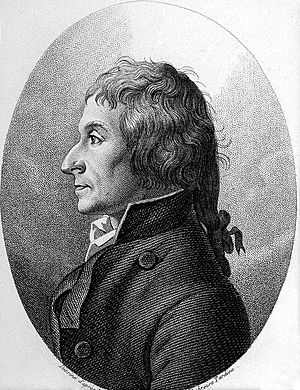Joseph Proust facts for kids
Quick facts for kids
Joseph Louis Proust
|
|
|---|---|
 |
|
| Born |
Joseph Louis Proust
26 September 1754 |
| Died | 5 July 1826 (aged 71) Angers, France
|
| Occupation | Chemist |
Joseph Louis Proust was a French chemist who lived from 1754 to 1826. He is famous for discovering the Law of Definite Proportions in 1794. This important law explains that chemical compounds always have the same elements combined in the same exact amounts.
Contents
Early Life and Education
Joseph Louis Proust was born in Angers, France, on September 26, 1754. His father was a pharmacist, and Joseph learned a lot about chemistry by working in his father's shop. Later, he moved to Paris and became the chief pharmacist at a hospital called Salpêtrière. He also taught chemistry with Pilâtre de Rozier, who was famous for flying hot air balloons.
Time in Spain
Proust later moved to Spain because Carlos IV wanted him there. He taught chemistry at the Chemistry School in Segovia and at the University of Salamanca. However, when Napoleon's army invaded Spain, Proust's laboratory was destroyed. He was then forced to return to France. He passed away in Angers, France, on July 5, 1826. A mineral called proustite is named in his honor.
Proust's Chemistry Discoveries
Proust's biggest achievement in science was proving the law of definite proportions. This law is sometimes called Proust's Law. He showed that chemical compounds always contain the same elements in the same proportions by weight. For example, water (H₂O) always has two parts hydrogen and one part oxygen.
Proving the Law
Proust studied different substances to prove his law. He looked at copper carbonate, two types of tin oxides, and two types of iron sulfides. He made artificial copper carbonate and compared it to natural copper carbonate. He found that both had the same exact proportions of copper, carbon, and oxygen.
He also showed that for compounds like tin oxides or iron sulfides, there were no "in-between" compounds. This meant that the elements always combined in specific, fixed ratios.
Acceptance of the Law
Proust published his findings in 1794. However, his law was not fully accepted by other scientists until 1812. That's when the Swedish chemist Jöns Jacob Berzelius gave him credit for his important discovery.
Exceptions to the Law
While the Law of Definite Proportions is very important, there are some exceptions. A group of substances called non-stoichiometric compounds, or Berthollides, do not always follow this rule. In these compounds, the ratio of elements can change slightly. For example, ferrous oxide (iron oxide) should ideally be FeO. But because of tiny gaps in its structure, it's often closer to Fe0.95O.
Sugar Studies
Proust was also very interested in the sugars found in sweet vegetables and fruits. In 1799, he showed his class in Madrid that the sugar in grapes is exactly the same as the sugar found in honey.
Works
- Translated to German in Journal für die Chemie und Physik vol. 1 (1806) p. 249-270
See also
 In Spanish: Louis Proust para niños
In Spanish: Louis Proust para niños

